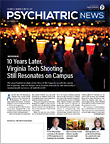As far as I was concerned, I had the year of serving as your president all sewn up. My penultimate act was to be in the lovely city of Adelaide in Australia in early May, where I was to represent APA at the Royal Australia New Zealand College of Psychiatrists (RANZCP) Biannual Meeting. After listening to the governor of South Australia talk about his commitment to mental health at the opening ceremony of the meeting, I was honored to describe the kinship between APA and RANZCP, both of which work closely with policymakers to make a difference for our patients. With that commitment behind me, I looked forward to enjoying the final stretch of my presidential year: the 2017 APA Annual Meeting in San Diego.
Nope! Of course not! So not sewn up! Because that is how the entire year has gone. Many plans in place; lots of intervention from the outside world. Naturally, there were all the planned activities: four Board meetings, two Assembly Meetings, the Institute on Psychiatric Services in Washington, D.C., and two Corporate Advisory Council meetings of the APA Foundation, to mention just a few. But peppered among all those meetings were what I affectionately referred to as the “pop-up” events—meetings and issues that “popped up” all over the place, all the time. Clearly, this was no ceremonial job, no “smile for the camera” job; it was more like a “no rest for the weary” job. So, if you are thinking of running for president, put on your running shoes, and not just for the campaign! Because there is a lot to do and a lot to learn, at least that was so for me. But that is what made it so wonderful. While I worked harder than I could have ever predicted, I was surrounded by wonderful APA staff and APA members ready to teach, ready to advise, and ready to roll up their sleeves.
In my mind, the category of unexpected issues could be divided into three camps.
First, there were the press issues. This was a very busy year, not only because of all the action around health care on Capitol Hill and the general interest in mental health, but most urgently around the Goldwater Rule. Some of the press was eager to report on APA’s rationale for it; others were simply looking to embarrass someone, in our case, APA. With the support of the excellent work of the Council on Communications and the fabulous APA Communications staff, I think we were able to keep APA’s reputation pristine while speaking clearly about our ethical commitment to protecting our patients and the public from improper armchair diagnoses.
Next, there were the policy issues. From the visit with the commissioner of the Food and Drug Administration (FDA) for a “listening session” to the panel discussion about the Patient-Centered Oriented Research Institute hosted by Sens. Bill Cassidy and Chris Murphy and the briefings on suicide and the opioid epidemic, there were ample opportunities to converse with key federal leaders about essential issues that confront our patients and our members. Importantly, it was a tremendous opportunity for APA (and me) to learn from leaders such as Dr. Nora Volkow about her views on how best to address the opioid epidemic and what APA can do to help and from Dr. Robert Cardiff about how APA can best support the FDA’s work by publishing practice guidelines to set standards in the space where FDA-approved treatments are limited. These are being translated into APA actions as we speak.
Third, there were the legislative issues. I don’t think I will forget the signing of the 21st Century Cures Act any time soon. There to represent APA, and flanked by my close buddies from the American Foundation for Suicide Prevention and my long-time colleague, Dr. Josh Gordon, who is now director of the National Institute of Mental Health, I watched with deep emotion as the legislation was signed into law by President Obama. At that same ceremony, I was also privileged to witness President Obama presenting Vice President Joe Biden with the country’s highest civilian award, the Medal of Freedom.
But yes, I was going somewhere with this. As I mentioned, there was more (unexpected) work to be done during the two-week hiatus between the RANZCP and APA meetings. On Thursday, May 11, I joined with several leaders of medical associations (ACP, AOA, AAFP, ACOG, and AAP) to meet with key Republican senators to express APA’s opposition to the American Health Care Act (AHCA).
So, I bet you get the picture: serving as APA president has been a lot of work. I have done it with gusto. I have learned a tremendous amount. I am grateful to have been entrusted by you, the APA membership, to work on your behalf. APA is as strong as ever, and it’s a good thing given all the challenges we face. ■

